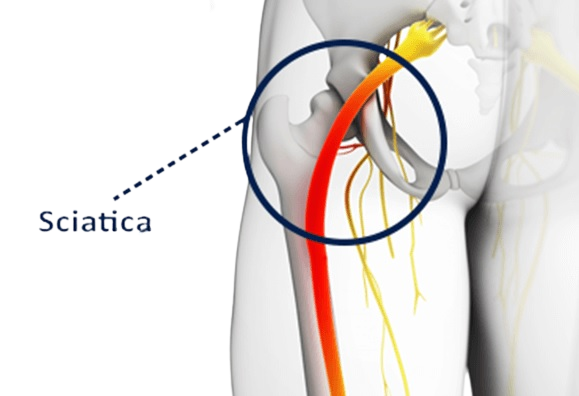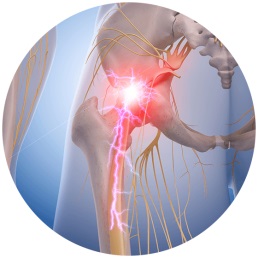Sciatica Symptoms & Treatment Options
Sciatica describes the pain and neurological symptoms that are associated with inflammation of the sciatic nerve. Located on either side of your lower body, these major nerves are the largest in the human body. Along with their roots from the lumbar and sacral spine, these nerves extend all the way from the lower spine, through the buttocks region, and down the backside of your legs to your feet. Moreover, your sciatic nerve is composed of five smaller nerves that branch out from the spinal cord. These “tributaries” eventually combine as one, like 5 streams joining to form one large river.
More importantly, your sciatic nerve is responsible for sending nerve impulses from the brain to your hamstring and lower body muscles. This crucial nerve influences movement, reflexes, and sensation. Following the tract of the hamstring, the sciatic nerve branches off into two smaller nerves. One of these nerves affects sensation, movement, and reflexes on the outside of your calf and the top of your foot. The other nerve fulfills the same purposes for your inner calf and ankle.
Why is Sciatica so Common?
Needless to say, the sciatic nerve covers a lot of ground in your body. It supplies a great deal of the movement and sensation to your legs. With such a large span and surface area, it leaves many opportunities for this nerve to become pinched or injured. Furthermore, any disruption to the sciatic roots or the main nerve itself can result in symptoms ranging from minor localized pain to debilitating, radiating pain or numbness. This incapacitating pain can significantly affect daily life and exclude one from participating in their regular activities such as work, hobbies, or even walking the dog.
Fortunately, sciatica, also known as sciatic nerve pain, is often easily diagnosed and can typically be treated with a variety of minimally invasive options. The first step to relief lies in identifying whether the sciatic nerve is the root of your problem. Call us.
Symptoms of Sciatica
Our legs and feet are our foundation. When these get disrupted, our whole world can be thrown off balance. The sciatic nerve plays a huge role in this foundation. When our sciatic nerve becomes irritated or pinched, it can lead to excruciating pain and disruptions in one’s daily life. So, what signs can you look for to know if your sciatic nerve is causing your lower back problems? Contact us to schedule an appointment with Dr. Martin, Board Certified Spine Surgeon.
Causes of Sciatica
Nearly 40% of individuals will experience some degree of sciatic pain in their lifetime according to various per reviewed reports. And, the occurrence of such cases only increases with age. This is often attributed to the size of the sciatic nerve system and the location of the nerves that compose this system. Many of the nerves in the sciatic system lie between vertebrae and other structures such as ligaments and muscles. Because of this proximity to other structures, one of the main sources of sciatic pain is a pinching of the sciatic nerve or any of its roots. This pinching can be caused by a variety of factors, including: injury, bulging or herniated discs, lumbar spinal stenosis, degenerative disc disease or arthritis, spondylolisthesis, spinal tumors, pregnancy, obesity, or lack of exercise and movement. In fact, even the type of mattress you sleep on can irritate the sciatic nerve.
A Pinched Or Injured Sciatic Nerve May Cause The Following Symptoms:
- An unnatural curve of the spine ranging from 10 degrees to 80 degrees or more
- An abnormal gait, leading to possible joint damage in the hips, knees, or ankles
- A pitched forward posture that makes it difficult to look ahead and ambulate
- Pain and stiffness in the lower back or in the location of the degenerative curve
- Tingling, loss of sensation, or stabbing pain because of pinched nerves and inflammation
- Difficulty breathing as the exaggerated curvature of the spine compresses the lungs
More about Dr. Matin
Sciatica Symptoms & Treatment Options
Sciatica pain can be treated by Dr. Martin, give us a call to schedule an appointment.
We will provide different options of treatment.
Pain Medication
Oral medications, both over-the-counter and prescription pain medications, are often an integral part of recovering from sciatica pain. Medications such as acetaminophen, ibuprofen, and naproxen may be suggested, whereas oral steroids and synthetic narcotics or stronger medications may work best for others.
Injections
A common form of treatment for sciatica, spinal injections target the pain at its source. Your physician will inject a ” cortisol like” steroid medication directly into the location of irritation. This will help to reduce inflammation, pain, and improve mobility.
Microdiscectomy
A microdiscectomy is a minimally invasive surgical solution that uses a microscope to visualize, remove, or repair a lumbar herniated disc. Removing a ruptured disc relieves sciatic nerve pain and neurological symptoms by decompressing the pinched sciatic nerve.
Laminectomy
A laminectomy is a common form of surgical correction for sciatica that results from spinal stenosis. During this procedure, your surgeon will remove a portion of the lamina to decompress pinched nerve tissue.






